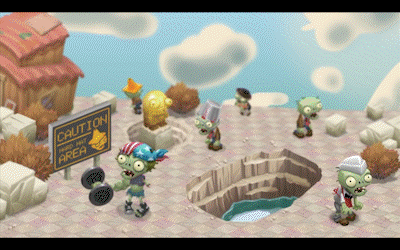
Clip from the Official PvZ Adventures launch trailer, via YouTube
Define the problem
As the Senior UX Designer on the PopCap game, Plants vs. Zombies Adventures, I was responsible for the UX and interaction design of every aspect of the game. I worked with game designers, product managers, and game artists to move from idea to execution.
Plants vs. Zombies Adventures differed from the original PC and mobile game by introducing the concept of defending a town instead of a single home. The game was built for Facebook, and followed city-building, social game conventions.
Social games are built around the concept of a core game loop, which is essentially the sequence of actions players do to complete a task and keep the game moving along. While building our game, we realized that our core game loop was short. To make the gameplay a little more interesting (and to keep players sticking around a little longer), we talked to people about the games they loved. People loved new challenges, new levels, new worlds. For PvZ Adventures, one idea rose to the top: The Road Trip. We'd let your character move from world to world. Travel to exotic, distant lands. Meet interesting zombies ... and kill them.
Once we had a direction, I took the lead on figuring out how the travel experience would work.
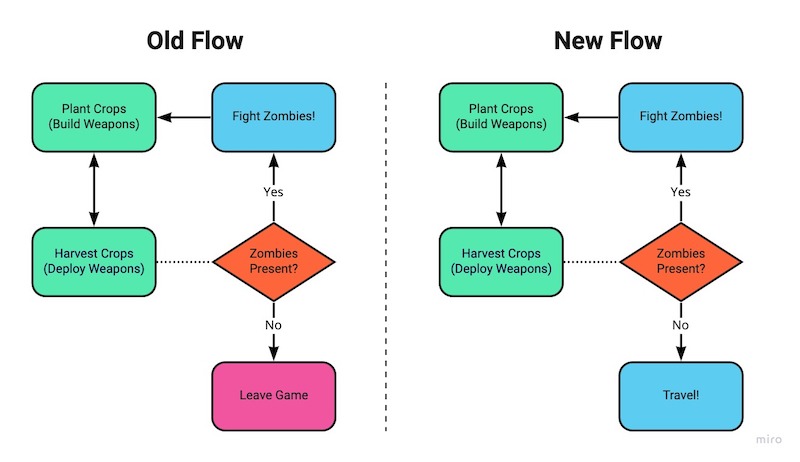
Background Research
A saga map is a fairly understood concept in social games, and the scale and orientation is often defined by the scope of the levels. I wanted our map to add to quirky narrative. The Road Trip theme referenced 1950s Americana and Route 66. We teased concept art with prospective players to determine interest in the concept. People loved the idea.
Business Goals
PvZ Adventures was a free game, so we made our money through microtransactions. The largest driver of microtransactions came from the purchase of hard currency (gems) that would pay for better gear or faster progression. The business goal was to encourage gem purchase by casual players (players who engaged a few hours a week), and everyday, expert players.
User Goals
Throughout the production of the game, we interviewed prospective players and actual players to understand their goals. For the Road Trip, players wanted to progress through levels, win battles, and collect rewards.
Hypothesis
By introducing the Road Trip mechanic to PvZ Adventures, we will increase the time spent playing the game and increase revenue through the sale of gems.
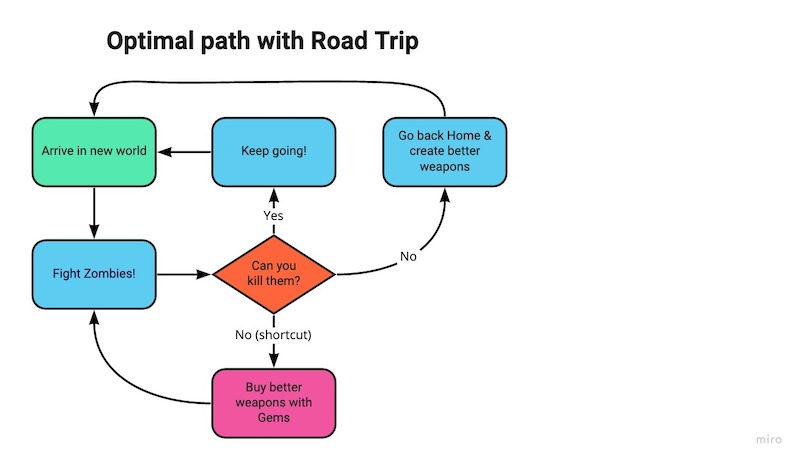
Requirements
The core team consisted of a Product Manager, a Game Designer, me (UX), and a team of engineers. I worked with PMs for revenue modeling and the Game Designers for level brainstorming.
Here are some of problems we had to solve:
- Movement between worlds
- Movement between levels
- Notifications between worlds
- Slowing progress (gates)
- Adding rewards
- Replayability
- Leaderboards
- PvP battles
To keep the player perspective in the forefront of what we did, we ran weekly play sessions in our studio for all team members to attend.
Iterate on solutions
Once we had the problems defined, it was time to create something we could test. The scope of the road trip was still to be determined, but I had an idea of how to include the map, the travel UX, and the leaderboard.
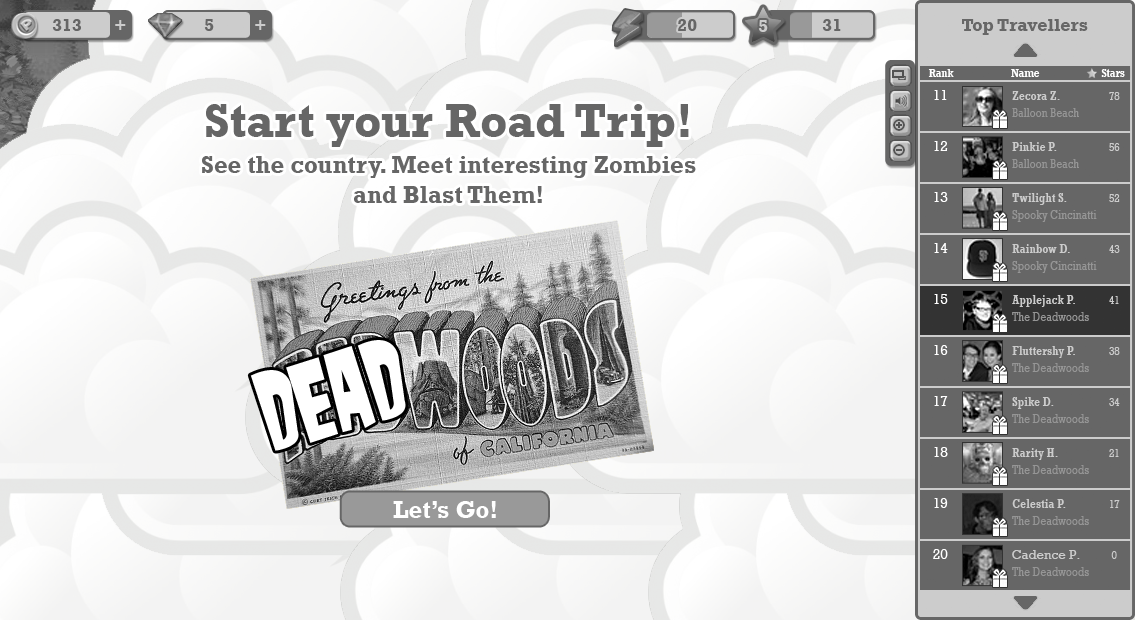
Wireframe detailing movement from Home to Road Trip.

Wireframe of a typical Road Trip level, showing buildable structure, levels, and leaderboard.
Longitudinal Study
Road Trip was an entirely new concept for our game, so we tested it through a longitudinal study where we kept track of players over an extended period of time. We selected 12 people living in the bay area who played social games, and asked them to play our game and keep a record of their progress. After 14 days we brought them in to our studio and interviewed them about the experience. The findings helped game design and usability design.

Study participants talking through their experience with the game.

Data collected through the study help us balance the gameplay.
Game Launch
Plants vs. Zombies Adventures launched on Facebook and was well-received by fans of hte genre. Our studio was involved with several important updates to the game, and the Road Trip mechanic proved very flexible to the business goals and a very fun part of the overall experience.
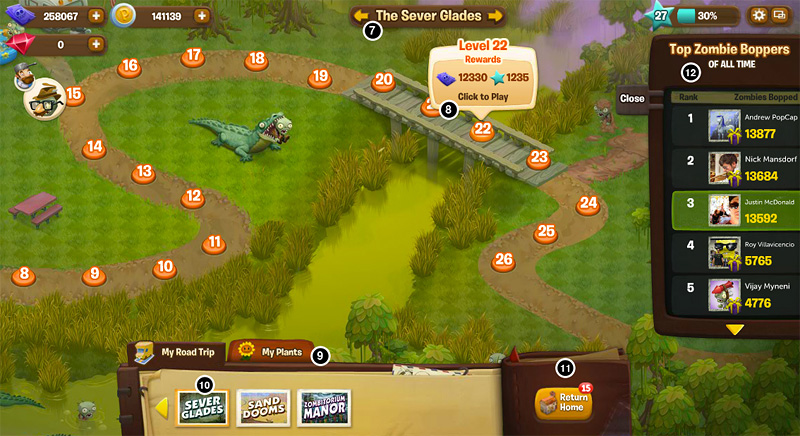
Final game art.
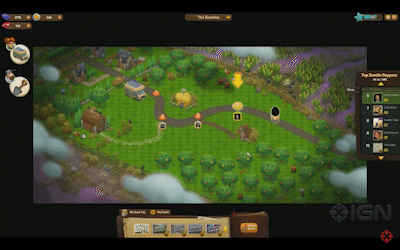
Clip from IGN walkthrough showing map and Road Trip UI, via YouTube.
Reflections
Through testing we discovered dozens of tweaks and polish tasks that made the game tighter and much more fun. When it launched, the Road Trip section of the game kept players entertained and returning. The magic of the Plants vs Zombies game franchise is in the game art, the writing, and the animations. My role in making the UX as fun and seemless as possible helped make a fun game that much better.